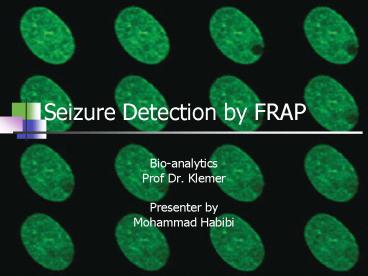Seizure Detection by FRAP PowerPoint PPT Presentation
1 / 25
Title: Seizure Detection by FRAP
1
Seizure Detection by FRAP
- Bio-analytics
- Prof Dr. Klemer
- Presenter by
- Mohammad Habibi
2
Outlines
- FRAP
- ECS
- Seizure Detection by FRAP
- Technical Tips
- Results and conclusion
3
What is FRAP?
- FRAP (Fluorescence Recovery After Photobleaching)
- Measuring the fluorescence in a defined region
of a sample after a bleaching process
4
How does it work?
- Tag molecules with fluorescein material
- Illuminate the region by very low intensity light
to obtain emitted light - Illuminate the region with very high intensity
short pulse laser (photo bleaching) - (basically the signal will be cut off by HI
laser) - Recording the progress of fluorescence recovery
in the bleached area with high temporal
resolution
5
FRAP Process
6
FRAP Process
7
Diffusion Coefficient Calculation
- Curve fitting
8
What kind of information does it provide?
- Changes in intensity in the bleached region
represent the sum of all movements of the
fluorescent molecules, whether passive (e.g.,
diffusion) or active (e.g., transport). - The regeneration time (half-recovery period) is a
measure of the speed of fluorescent molecules
movement
9
Schematic
10
FRAP Equipment
CCD camera
Argon laser
Laser optics
11
Why do we need to know about diffusion?
- Many types of diseases can be diagnosed by the
diffusion coefficient information - Such as
- Brain edema
- Alzheimer's disease
- Epilepsy (Seizure)
12
Is the FRAP only way to measure diffusion?
- NO,
- Diffusion can be measured by
- Radiotracer
- Diffusion-weighted MRI
- TMA (tetramethylammonium)
13
FRAP Advantages
- Minimally invasive (avoid damage related to
micropipette) - Can be applied to study of many types of
macromolecules such as DNA, Protein,
carbohydrates - Excellent temporal and spatial resolution
- well suited for measurement in vivo
14
Key Elements in FRAP
- Laser intensity before bleaching (detecting
signal with acceptable SNR) - Laser intensity during bleaching (4000 fold)
- Laser pulse time bleaching (1-5 msec)
- Sampling 500 msec after bleaching
15
Extracellular Space (ECS)
- 20 of the brain volume
- Jelly-like matrix ( ions, neurotransmitter,
metabolites, peptides, ECS molecules) - Forming the microenvironment for all cells,
mediating glia-neuron communication via
diffusible metabolites, ions - Non-synaptic communication or volume
transmission - ECS plays important role in pathological
condition like brain edema or seizure activity
16
Detecting seizure by FRAP
- The experiment has been done on a mouse
- 1) exposing the intact dura
- 2) loading fluorescein-dextrans
- (dissolve with aCSF)
- 3) loading time from 1hr to 2 hrs
17
Loading of ECS by Fluorescein
18
Detecting (Cont)
- 4) Recording the signal at detector before and
after bleaching - 5) injection of PTZ to model generalized seizure
- 6) Recording the signal before bleaching
- 7)Photobleaching and recording signal
- (before seizure , during seizure and after
seizure) - Results
- Seizure caused changes in diffusion
coefficient before and after seizure activity
19
Detecting Seizure Result
20
Schematic
21
Instruments characters
- Laser first order beam, 2 Watt, 488 nm, argon
ion - Acousto-optic modulator
- Dichronic mirror , 510 nm
- Objective lens 50,numerical aperture 0.55,
working distance 8 mm, Nikon air - Photomultiplier, amplifier, A/D(14 bits)
22
Experiment process
- Sampling fluorescence continuously for 200 msec
before bleaching - Sampling at 1 Mhz after bleaching and over 500
msec after bleaching - Repeating process for 10 to 60 sec
- Curve fitting - using non-linear least squares to
find half-time recovery t 1/2 - F(t) is fluorescent recovery function
23
Key Points
- Type of fluorescein material (4,70,500 kDa)
- Loading time
- Timing issue
- Laser power
- Calibration is required in this method
- Excellent Temporal resolution (less than 1 min)
- Simple signal processing
24
Conclusion
- FRAP can be applied to detect and predict
seizures - However its an invasive technique
25
- Questions?

